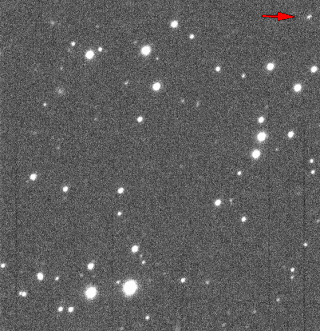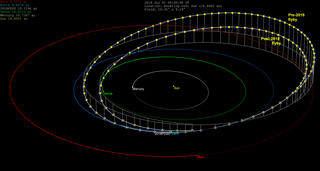Related Research Articles
(444004) 2004 AS1, provisional designation 2004 AS1, and also known by the temporary name AL00667, is a sub-kilometer asteroid, classified as near-Earth object and potentially hazardous asteroid of the Apollo group, approximately 300 meters in diameter.

1221 Amor is an asteroid and near-Earth object on an eccentric orbit, approximately 1 kilometer (0.6 miles) in diameter. It is the namesake of the Amor asteroids, the second-largest subgroup of near-Earth objects. It was discovered by Eugène Delporte at the Uccle Observatory in 1932, the first time that an asteroid was seen to approach Earth so closely. The assumed S-type asteroid is one of few low-numbered asteroids for which no rotation period has been determined. It was assigned the provisional designation 1932 EA1 and named for Cupid, also known as "Amor" in Latin, the Roman equivalent of the Greek god Eros.
(612600) 2003 SM84 is a sub-kilometer asteroid, classified as near-Earth object of the Amor group orbiting between Earth and Mars. It was first observed by the Lincoln Near-Earth Asteroid Research (LINEAR) at the Lincoln Laboratory ETS on 20 September 2003. As of 2020, this minor planet has neither been nor named.
(7025) 1993 QA is a sub-kilometer asteroid classified as near-Earth object of the Apollo and Amor group, respectively. It was discovered on 16 August 1993, by astronomers of the Spacewatch program at the Kitt Peak National Observatory near Tucson, Arizona, United States. The asteroid measures approximately half a kilometer in diameter and has a short rotation period of 2.5057 hours.
(251732) 1998 HG49, provisional designation 1998 HG49, is a sub-kilometer asteroid and near-Earth object of the Amor group, approximately 200 meters in diameter. It was discovered on 27 April 1998 by astronomers of the Spacewatch program at the Kitt Peak National Observatory near Tucson, Arizona, United States.
(350462) 1998 KG3, is a sub-kilometer asteroid and near-Earth object of the Amor group, that is on a low-eccentricity and low-inclination orbit between the orbits of Earth and Mars. It was discovered by the Spacewatch survey at Kitt Peak National Observatory on 22 May 1998.
2006 JY26 is a near-Earth object that is also horseshoe companion to the Earth like 3753 Cruithne.
2012 FC71, also written 2012 FC71, is a small asteroid trapped in a Kozai resonance with the Earth.

(511002) 2013 MZ5, provisional designation 2013 MZ5, is a sub-kilometer asteroid, classified as a near-Earth object of the Amor group, estimated to measure approximately 300 meters (1,000 feet) in diameter. It was discovered on 18 June 2013, by astronomers with the Pan-STARRS survey at Haleakala Observatory on the island of Maui, Hawaii, in the United States. It was the 10,000th near-Earth object ever discovered.
(523662) 2012 MU2, provisional designation 2012 MU2, is a sub-kilometer asteroid on an eccentric orbit, classified as near-Earth object and potentially hazardous asteroid of the Apollo group. It was discovered on 18 June 2012 by astronomers of the Catalina Sky Survey at an apparent magnitude of 19.9 using a 0.68-meter (27 in) Schmidt–Cassegrain telescope. It has an estimated diameter of 240 meters (790 ft). The asteroid was listed on Sentry Risk Table with a Torino Scale rating of 1 on 23 June 2012.
2014 EC is a 10-meter sized, eccentric asteroid, classified as near-Earth object of the Apollo group that passed within 48,000 miles (77,000 km) of Earth in early March 2014. This was six times closer to the Earth than the Moon. It was first observed on 5 March 2014, by the Catalina Sky Survey at Mount Lemmon Observatory in Arizona, United States. As of 2017, it has not since been observed.
(391211) 2006 HZ51 is a bright, sub-kilometer asteroid on an eccentric orbit, classified as a near-Earth object and a potentially hazardous asteroid of the Amor group. It was discovered on 27 April 2006, by astronomers of the Catalina Sky Survey conducted at Mount Lemmon Observatory, Arizona, United States. During preliminary observations, it was thought to have a small chance of impacting Earth in 2008. The asteroid measures approximately half a kilometer in diameter and has an exceptionally high albedo.

(523972) 1999 CW8, provisional designation 1999 CW8, is a bright carbonaceous asteroid and sub-kilometer near-Earth object of the Apollo group, first observed on 12 February 1999, by astronomers of the Lincoln Near Earth Asteroid Research program at Lincoln Laboratory ETS in New Mexico, United States.
1993 DA is a sub-kilometer asteroid, classified as a near-Earth object of the Aten group. It has only been observed during 5 days in February 1993, and not been detected ever since. The small body measures approximately 20 meters in diameter based on an absolute magnitude of 26.4, and has an Earth minimum orbital intersection distance of 13.8 lunar distances or 0.0355 AU (5,310,000 km).

2017 BQ6 is a sub-kilometer asteroid on an eccentric orbit, classified as a near-Earth object and potentially hazardous asteroid of the Apollo group, approximately 150 meters in diameter. It was discovered on 26 January 2017, by the Space Surveillance Telescope at Lincoln Laboratory's ETS (Atom Site) and passed within 6.6 lunar distances of Earth on 7 February 2017 at 6:36 UT.

In the astronomy of the Solar System, 2017 BS5 is a sub-kilometer asteroid, classified as near-Earth object that belongs to the Apollo group. It measures approximately 40–90 meters. During a close approach to Earth, it was first observed 25 January 2017, by the ATLAS survey at Haleakala Observatory, Hawaii, United States.

2017 OO1 is a small asteroid, classified as near-Earth object of the Aten group, approximately 35–76 meters (115–249 feet) in diameter. It was first observed on 23 July 2017, by the robotic ATLAS survey at Mauna Loa Observatory, Hawaii, two days after the object had approached Earth at 0.33 lunar distances on 21 July 2017.

2018 PD20 is a small asteroid, classified as a near-Earth object of the Apollo group, approximately 9–20 meters (30–66 feet) in diameter. On 11 August 2018, it was first observed by ATLAS at the Mauna Loa Observatory on Hawaii (T08), when it passed 33,500 kilometers (20,800 miles) from the Earth. This is notable because it came within a tenth of the lunar distance, or 0.10 LD which is closer to Earth than satellites in a geostationary orbit. These have an altitude of 0.11 LD, about 36,000 km (22,000 mi), approximately 3 times the width of the Earth.

2019 AQ3 is an inclined near-Earth object of the small Atira group from the innermost region of the Solar System, estimated to measure 1.4 kilometers (0.9 miles) in diameter. Among the hundreds of thousands known asteroids, 2019 AQ3's orbit was thought to have likely the smallest semi-major axis (0.589 AU) and aphelion (0.77 AU), that is, the orbit's average distance and farthest point from the Sun, respectively. The object was first observed on 4 January 2019, by astronomers at Palomar's Zwicky Transient Facility in California, with recovered images dating back to 2015.
2020 VT1 is a small asteroid, classified as a near-Earth object of the Amor group, that is a temporary horseshoe companion to Mars.
References
- 1 2 3 4 5 "JPL Small-Body Database Browser: 225312 (1996 XB27)" (2014-07-28 last obs.). Jet Propulsion Laboratory. Retrieved 16 January 2018.
- 1 2 3 4 "225312 (1996 XB27)". Minor Planet Center. Retrieved 16 January 2018.
- 1 2 NeoDys-2 Retrieved 2011-09-04
- ↑ Evans, N. Wyn; Tabachnik, Serge (May 1999). "Possible long-lived asteroid belts in the inner Solar System". Nature. 399 (6731): 41(NatureHomepage). arXiv: astro-ph/9905067 . Bibcode:1999Natur.399...41E. doi:10.1038/19919. S2CID 4418335.
- ↑ JPL close-approach data Retrieved 2011-09-04